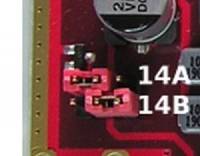User Tools
Sidebar
Table of Contents
AMSAT-DL QO-100 DownConverter V3d
Connectors
- NB-LNA-IN: Connection to the LNB. F-connector, 75 Ohm. Socket is supplied
- WB-OUT: Output WB transponder, connect to DVB-S2 receiver, F-connector, 75 Ohm. Socket is supplied
- WB-LNB-IN: connection to LNB. F-connector, 75 Ohm. Socket is supplied. Here is also the reference clock for the LNB.
- NB-OUT: Output NB transponder, connect to receiver, BNC socket is supplied.
- 12V supply voltage
- Rotary switch for setting the output frequency (NB-Transponder)
- 10M-REF: 10 MHz reference output, SMA connector, to connect an up-converter or an ICOM IC9700
- GPS connector, here the GPS module is plugged in or alternatively an own reference
- 40 MHz reference output. 2 pin header, to connect the AMSAT-DL upconverter or a SDR (e.g. Adalm Pluto)
- two jumpers to select the LNB frequency
- (only versions 2019/2020) Poti for adjustment of the OCXO (unused with TCXO). Target frequency 40.0 MHz
- TCXO (with versions 2019/2020 also OCXO)
- LED … lights up when GPS or an ext. reference is active
- LED … operation indicator, lights up as soon as 12V supply is connected
- 10 pin connector for optional display
- four LEDs for indication of operating status
- output filter (to be bridged during 70cm operation)
12V connection:
A wide supply voltage range of 8 to 15 V is supported here. At 13.8V, the current consumption is about 200mA. In the downconverters shipped in 2019/2020 with OCXO, the current consumption during the heat-up phase was about 500mA. This was also a reason to completely switch to the GPS-based solution.
LNB-14V/18V switching
The switching of the polarization plane (V)ertical / (H)orizontal is done by the power supply respectively 14V or 18V. The V-plane is used for the NB transponder, the WB transponder is on the H-plane. Users in South America or Southeast Asia with large skew angles can exchange this configuration, as well as if the LNB was installed rotated by 90°.
14A is for the NB LNB (position shown in the picture: 14V)\\. 14B is for the WB LNB (position shown in the picture: 18V)
LNB reference frequency selection:
both open … 24 MHz (default)
10A bridged … 25 MHz
10B bridged … 26 MHz (for LNB with 27 MHz crystal)
both bridged … for future extensions
10 MHz and 40 MHz output:
The following reference signals are available:
10 MHz REF OUT: solder eyes for SMA connector, 10MHz 50Ohm, 0dBm, sinus\\. 40 MHz REF OUT: 2-pin connector, 40 MHz, 3Vpp CMOS level, square wave, left signal, right ground.
Output frequency selection:
LEDs:
A … LNB power supply: dc5x
B … down mixer: LOCK
C … blinking when device is active
D … central PLL: SYNC
GPS / ext. reference connector:
5 pin jumper (pitch 2.54mm). Pins from left to right:
1 … 3.3 Volt\\. 2 … ground\ 3 … serial GPS connector 4 … serial GPS connector / debug output connector 5 … reference signal input
GPS operation The GPS module is plugged in and the GPS antenna is connected. The included GPS module V2 will be detected automatically. (This will not work if you are eliminating a 2019/2020 delivered OCXO variant). Ext. reference:**
A 10 MHz signal is connected to pin 5 (min. 1Vpp, max. 3.3Vpp, 100 Ohm impedance). Additionally pin 3 and pin 4 have to be connected with a jumper.









